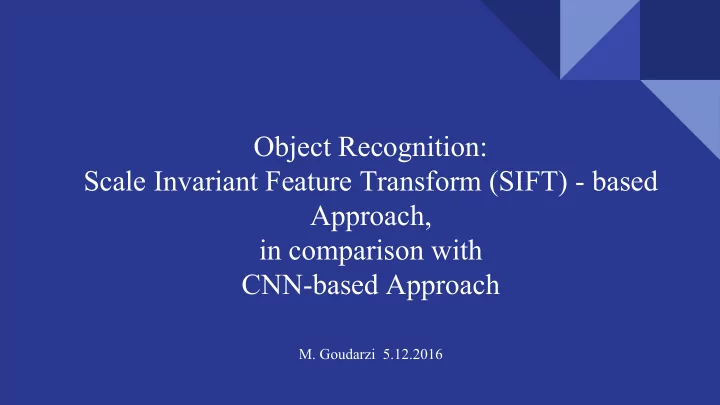

Object Recognition: Scale Invariant Feature Transform (SIFT) - based Approach, in comparison with CNN-based Approach M. Goudarzi 5.12.2016
Object Recognition: an overview ● You meet a new person or an object, what makes you recognize them the next day? What helps our brain to first detect and then ● recognize we are meeting the same person again? ● Does our brain “tag” what it sees? M. Goudarzi 5.12.2016 2
Object Recognition: an ● You meet a new person or an object, overview what makes you recognize them the next day? ● Is it the Facial Expression? ● Their Haircut? Their shape and size? ● etc. ● M. Goudarzi 5.12.2016 3
Object Recognition: an overview ● You meet a new person or an object, what makes you recognize them the next day? ● Is it the Facial Expression? [1] M. Goudarzi 5.12.2016 4
Object Recognition: an overview ● You meet a new person or an object, what makes you recognize them the next day? ● Is it the Facial Expression? Is it the haircut? ● ● Is it a shape and size M. Goudarzi 5.12.2016 [3] 5
What makes us detect, remember and ● Object recognize an object? ● Would we still remember an Recognition: an object/person when their disguised, re-colored, occluded , etc. overview. ● What does our brains react to in terms of attention, detection and recognition. M. Goudarzi 5.12.2016 6
Human Visual System ● Evolved over 500 million years. Adapted to the environment over time. ● Nuance Detection. ● ● HVS Model used in Computer Vision and Image Processing. M. Goudarzi 5.12.2016 7
Some insightful reads: Object Recognition: Perspectives from Cognitive Psychology and Neuroscience [4,5,6] M. Goudarzi 5.12.2016 8
A human visual system model (HVS Human Visual ● model) is used by computer vision System (HVS) experts to deal with biological and psychological processes that are not yet fully understood. model Assumptions need to be made: ● Low-Pass filter characteristics. (Mach Bands) Lack of color resolution ● ● Motion sensitivity ● Integral face recognition etc. ● M. Goudarzi 5.12.2016 9
Human Visual System (HVS) model [7] M. Goudarzi 5.12.2016 10
Human Visual System (HVS) model [8] M. Goudarzi 5.12.2016 11
Man vs. The Machine Human object recognition vs. ● computer-based Object recognition system ● Fundamental Difference in semantics. M. Goudarzi 5.12.2016 12
Man vs. The Machine [9] M. Goudarzi 5.12.2016 13
Man vs. The Machine M. Goudarzi 5.12.2016 [9] 14
Man vs. The Machine ● To human beings, this is not just “a boy sitting with a pair of shoes” ● Context matters to us. [11] M. Goudarzi 5.12.2016 15
Man vs. The Machine ● Our perception of images changes with the surrounding context, including those including sound and rhythms. [12] M. Goudarzi 5.12.2016 16
Introduced by David Lowe in 1999 SIFT Features ● ● Published in 2004 [13] M. Goudarzi 5.12.2016 17
Goal: Extracting distinctive features SIFT Features ● which are invariant to common image transformations. ● Invariance to image rotation and scale. Local operation ● ● Close to real-time performance ● Robust w.r.t : Affine Transformation ○ ○ Noise Viewpoint Change ○ M. Goudarzi 5.12.2016 18
SIFT Features ● Scale-space peak selection Steps of Potential feature locations ○ ● Key-point localization key-point ○ Locating key-points accurately Orientation assignment ● extraction: ○ Orientation assignment ● Key-point descriptor ○ Vectorizing key-point descriptions M. Goudarzi 5.12.2016 19
SIFT feature: Blob detection [14] M. Goudarzi 5.12.2016 20
SIFT feature: Laplace of Gaussian : LoG [15] M. Goudarzi 5.12.2016 21
SIFT Features: LoG approximation with DoG [16] M. Goudarzi 5.12.2016 22
SIFT Features: Orientation Assignment [16] M. Goudarzi 5.12.2016 23
SIFT Feature Matching [17] M. Goudarzi 5.12.2016 24
Bag of visual words (BoW) approach ● How to recognize an object from what has been already learned. [18] M. Goudarzi 5.12.2016 25
BoW - inspired by “Document Searching” [19] M. Goudarzi 5.12.2016 26
BoW Approach - using SIFT Features [19] M. Goudarzi 5.12.2016 27
HMAX: A CNN-based bio-inspired Object Recognition approach [20] M. Goudarzi 5.12.2016 28
HMAX: A CNN-based bio-inspired Object Recognition approach [20] 29 M. Goudarzi 5.12.2016
Convolutional Neural Network Real-Time Face Detection M. Goudarzi 5.12.2016 [21] 30
Comparison between SIFT-based vs. HMAX Object Recognition Approach. SIFT: pros and cons. Disadvantages Fundamentally different from human brain mechanism. Loses spatial information Requires careful tweeting If not used carefully can include noises into features M. Goudarzi 5.12.2016 31
Comparison between SIFT-based vs. HMAX Object Recognition Approach. CNN: pros and cons. Advantages Disadvantages Use of shared weight for C-layer Requires intensive computational power and taking too long to train Independent from human effort Too much of a “Black Box” Invariance to certain features Difficult to add training samples later on Closer to human brain mechanism Difficult to use properly, more knowledge demanding M. Goudarzi 5.12.2016 32
References: [1] http://kanigas.com/donald-trump-2/ [2] David Labov, http://www.skilja.de/2012/classification-and-context/, last accessed http://www.skilja.de/wp-content/uploads/2012/03/Labov-Cups-2.png [4] Sacks, O. (1985). The man who mistook his wife for a hat and other clinical tales . New York: Summit Books. Photo available via http://t3.gstatic.com/images?q=tbn:ANd9GcT1idlXjD7CkbIAv3Kk2-riy_Tk_8RiUE3mnlfU55KQUnslhyEa [5] Levitin, D. J. (2014). The organized mind: Thinking straight in the age of information overload . New York, NY: Dutton. Photo available via: http://blogs.lse.ac.uk/impactofsocialsciences/files/2015/01/9780670923106-1.jpg [6] Thinking, Fast and Slow. (2015). College Music Symposium, 55 . doi:10.18177/sym.2015.55.ca.10990. Photo available via: http://2.bp.blogspot.com/-f7SFFKhuXn0/UflzrpGguSI/AAAAAAAAAG0/0X-W0YZp7rw/s1600/Thinking+Fast+and+Slow.jpg M. Goudarzi 5.12.2016 33
References (cont.) [7] optical illusion cube http://www.nerdist.com/wp-content/uploads/2015/02/DressIllusion_3.jpg [8] optical illusion cube revealed http://news.bbcimg.co.uk/nol/shared/bsp/hi/dhtml_slides/10/illusion3/img/illusion_dhtml_7_v2.gif [9] Fei Fei, Stanford, TED Talk. https://www.youtube.com/watch?v=40riCqvRoMs&t=217s [11] Austrian Child embracing shoes - 1946 http://65.media.tumblr.com/tumblr_mcb4x5GoH61qgwmzso1_r1_1280.jpg https://dl.dropboxusercontent.com/u/4001169/TUMBLR/BLOG%20-%20FROM%20A%20TO%20B/PHOTOS/34117773241_gerald_waller_LARG E.jpg First published in LIFE Magazine. [12] https://www.youtube.com/watch?v=vAEFmurII-A M. Goudarzi 5.12.2016 34
References (cont.) [13] David Lowe http://www.cs.ubc.ca/~lowe/photoCredit.html [14] Object Recognition using SIFT http://www.di.ens.fr/willow/teaching/recvis10/assignment1/ [15] VLFEAT SIFT http://www.vlfeat.org/overview/sift.html [16] http://homepages.inf.ed.ac.uk/rbf/HIPR2/log.htm [17] Open CV - SIFT Features. http://docs.opencv.org/trunk/d5/d3c/classcv_1_1xfeatures2d_1_1SIFT.html M. Goudarzi 5.12.2016 35
[18] Bag of Visual Words model http://www.robots.ox.ac.uk/~az/icvss08_az_bow.pdf [19] Serre, T. and Riesenhuber, M. (2004) [20] https://www.quora.com/What-are-the-pros-and-cons-of-neural-networks-from-a-practical-perspective. [21] http://maxlab.neuro.georgetown.edu/hmax.html [20] https://www.quora.com/What-are-the-pros-and-cons-of-neural-networks-from-a-practical-perspective. [21] https://www.youtube.com/watch?v=ptzpJwtbPp0 M. Goudarzi 5.12.2016 36
Recommend
More recommend